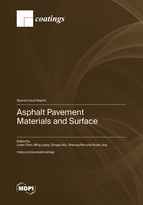Asphalt Pavement Materials and Surface
A special issue of Coatings (ISSN 2079-6412). This special issue belongs to the section "Surface Characterization, Deposition and Modification".
Deadline for manuscript submissions: closed (31 October 2022) | Viewed by 65270
Special Issue Editors
Interests: construction and maintenance of steel bridge deck pavement; digital twin; smart highway
Special Issues, Collections and Topics in MDPI journals
Interests: asphalt pavement materials; intelligent monitoring for road infrastructure
Special Issues, Collections and Topics in MDPI journals
Interests: the meso-damage mechanism of asphalt mixture; fatigue damage behavior of asphalt and asphalt mixture; reliability and performance of recycled infrastructure materials; pavement surface functional characteristics
Interests: molecular dynamics simulations; construction materials chemistry; adhesion and interface chemistry; bituminous materials
Special Issues, Collections and Topics in MDPI journals
Interests: pavement durability; green and sustainable pavement materials
Special Issues, Collections and Topics in MDPI journals
Special Issue Information
Dear Colleagues,
Asphalt pavement is one of the most important infrastructures used in roads, bridges and airports. Due to the weakened mechanical properties of asphalt materials and interfacial adhesion between asphalt and aggregates, diseases in asphalt pavement occur frequently. The development of high-quality asphalt materials and full understanding of surface behaviors are both significant to prevent these diseases and prolong the service life of asphalt pavement. Over the past decades, asphalt pavement materials and design guides have developed dramatically and, as a consequence, material behaviors and the pavement response has changed significantly. In this case, new methods and research are needed to discover the service behavior of the materials and surface.
Although pavement technology has developed significantly, new techniques such as the development and modification of new asphalt material and the characterization of materials and structures are still being studied all over the world. New methods such as artificial intelligence and big data analysis have also widened the research field. The construction and preservation technique of asphalt pavement under the new circumstances are a critical challenge for pavement researchers and technologists.
Hence, this Special Issue focuses on the asphalt materials and surface. The particular topics of interest for this Special Issue include but are not restricted to:
- Modification technology of asphalt binder
- Aging and recycling of asphalt binder
- Interfacial characterization of asphalt materials
- Numerical modeling of interfacial asphalt–aggregate systems
- Multiscale study on adhesion and moisture damage of asphalt surface
- Warm and cold mix asphalt materials
- Smart pavement materials and structures
- Pavement monitoring and smart roads
- Performance evaluation and prediction
Prof. Dr. Leilei Chen
Prof. Dr. Ming Liang
Prof. Dr. Dongyu Niu
Dr. Shisong Ren
Dr. Ruxin Jing
Guest Editors
Manuscript Submission Information
Manuscripts should be submitted online at www.mdpi.com by registering and logging in to this website. Once you are registered, click here to go to the submission form. Manuscripts can be submitted until the deadline. All submissions that pass pre-check are peer-reviewed. Accepted papers will be published continuously in the journal (as soon as accepted) and will be listed together on the special issue website. Research articles, review articles as well as short communications are invited. For planned papers, a title and short abstract (about 100 words) can be sent to the Editorial Office for announcement on this website.
Submitted manuscripts should not have been published previously, nor be under consideration for publication elsewhere (except conference proceedings papers). All manuscripts are thoroughly refereed through a single-blind peer-review process. A guide for authors and other relevant information for submission of manuscripts is available on the Instructions for Authors page. Coatings is an international peer-reviewed open access monthly journal published by MDPI.
Please visit the Instructions for Authors page before submitting a manuscript. The Article Processing Charge (APC) for publication in this open access journal is 2600 CHF (Swiss Francs). Submitted papers should be well formatted and use good English. Authors may use MDPI's English editing service prior to publication or during author revisions.










